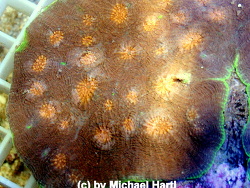Info
Fenner and Veron, 2000
Description: Colonies are thin delicate laminae with widely but uniformly spaced corallites. Corallites are well defined, becoming immersed, with indistinct walls. Septo-costae form parallel striations irrespective of the position of corallites. Most septa radiate from the corallite centre, but those adjoined to costae remain aligned with the costae. Septo-costae inside corallites are in three indistinct orders. Columellae consist of a few septal spines or are absent.
Abundance: Rare.
Similar Species: No other Echinophyllia has septo-costae crossing corallites. Echinophyllia pectinata has similar thin laminae and corallites of similar size.
For more Infos and Pictures click to the Link to Aims Website.
Classification: Biota > Animalia (Kingdom) > Cnidaria (Phylum) > Anthozoa (Class) > Hexacorallia (Subclass) > Scleractinia (Order) > Lobophylliidae (Family) > Echinophyllia (Genus) > Echinophyllia costata (Species)







 Dr. John Edward Norwood "Charlie" Veron, Australien, Australien
Dr. John Edward Norwood "Charlie" Veron, Australien, Australien













